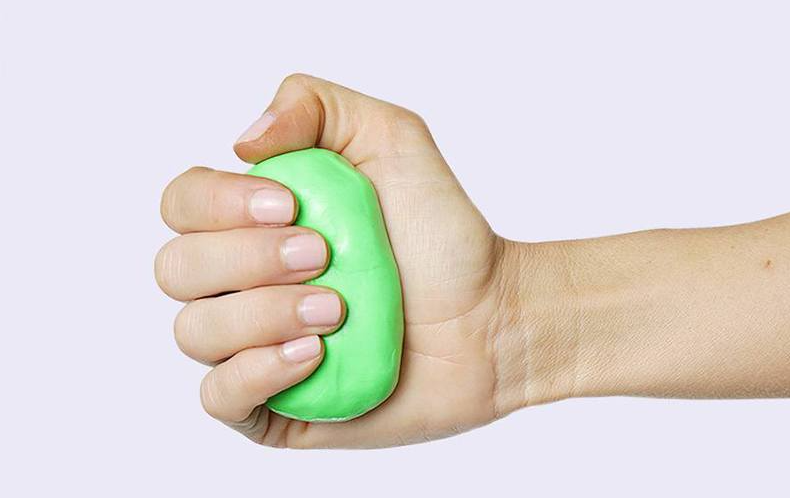Effective Carpal Tunnel Exercises (CTS) is a common condition that plagues millions, turning daily tasks into frustrating fumbles. The culprit? A compressed median nerve snagged at the wrist’s narrow carpal tunnel. The result? Tingling, numbness, weakness, and pain radiating from your palm to your fingers.
But fear not, fellow keyboard warriors and craft connoisseurs! Before resigning yourself to a life of ergonomic gloves and voice dictation, consider the power of carpal tunnel exercises.
Prepping Your Wrists for Action
Before diving into the exercises, a proper warm-up is crucial to prevent injury and maximize effectiveness. Here’s a simple routine to get your blood flowing:
- Wrist circles: Extend your arms out in front of you, palms facing down. Make small circles with your wrists, 10 rotations forward and 10 backward, for each arm.
- Finger stretches: Gently stretch each finger back one at a time, holding for 5 seconds each. Repeat with the thumb.
- Prayer poses: Press your palms together in front of your chest, fingers pointing upwards. Gently push your hands down towards your waist, feeling a stretch in your forearms. Hold for 15 seconds.
Remember, listen to your body and stop if you experience any pain.
Effective Carpal Tunnel Exercises

Now, let’s meet the star players in our quest for carpal tunnel relief:
Wrist Flexion Stretch
- Extend your arm out in front of you, palm facing down.
- Use your other hand to gently bend your wrist back towards the floor, stretching the palm side of your wrist.
- Hold for 15-30 seconds and repeat on the other side.
Wrist Extension Stretch
- Extend your arm out in front of you, palm facing up.
- Gently bend your wrist back towards yourself, stretching the top of your wrist.
- Hold for 15-30 seconds and repeat on the other side.
Radial Deviation Stretch
- Extend your arm out in front of you, palm facing down.
- Tilt your hand towards your thumb, stretching the outer side of your wrist.
- Hold for 15-30 seconds and repeat on the other side.
Ulnar Deviation Stretch
- Extend your arm out in front of you, palm facing down.
- Tilt your hand towards your pinky finger, stretching the inner side of your wrist.
- Hold for 15-30 seconds and repeat on the other side.
Nerve Glide
- Place your hand flat on a table, palm facing down.
- Slowly and gently glide your fingers back and forth across the table, as if “milking” the surface.
- Repeat for 30 seconds.
Finger Extension and Flexion
- Make a fist with your hand, then slowly extend your fingers as wide as possible.
- Hold for 5 seconds, then slowly curl your fingers back into a fist.
- Repeat 10 times.
Thumb Opposition
- Touch the tip of your thumb to the tip of each of your fingers, one at a time.
- Hold each position for 5 seconds.
- Repeat 5 times for each finger.
Hand Massage
- Gently massage your palm, fingers, and wrist with your thumb and other fingers.
- Apply gentle pressure to any tight or tender spots.
- Continue for 2-3 minutes.
Bonus Tip: Incorporate these exercises into your daily routine, performing them several times throughout the day. Consistency is key to maximizing their effectiveness!
Beyond Exercises Lifestyle Tweaks for Lasting Relief

- Grip Modifications: Use tools with thicker handles to reduce grip pressure. Opt for voice recognition software to minimize typing.
- Ice and Heat Therapy: Apply ice packs to your wrists for 15-20 minutes at a time to reduce inflammation. Alternately, use a heating pad for 15 minutes before bedtime to improve circulation and ease stiffness.
- Splinting: Consider wearing a wrist splint at night to keep your wrist in a neutral position and prevent further compression of the median nerve.
- Maintain a Healthy Weight: Excess weight can put additional strain on your wrists, so maintaining a healthy weight can be beneficial.
- Dietary Strategies: Certain foods rich in vitamin B6 and magnesium, like bananas, leafy greens, and nuts, can support nerve health.
- Stay Hydrated: Dehydration can worsen carpal tunnel symptoms. Aim to drink plenty of water throughout the day.
Remember, consulting a healthcare professional is crucial for the proper diagnosis and treatment of carpal tunnel syndrome. They can recommend personalized strategies based on the severity of your case and underlying conditions.
Advanced Techniques for Persistent Symptoms
If your carpal tunnel symptoms persist despite conservative measures, your doctor may recommend further interventions, such as:
- Corticosteroid injections: These injections can reduce inflammation around the median nerve, providing temporary relief.
- Ultrasound therapy: This therapy uses sound waves to promote healing and reduce pain.
- Surgery: In severe cases, surgery to release the carpal tunnel may be necessary to permanently decompress the median nerve.
Remember: Early diagnosis and intervention are key to managing carpal tunnel syndrome effectively and preventing long-term complications. Don’t hesitate to seek professional help if your symptoms are impacting your daily life.
Strengthening Exercises for Enhanced Protection
While stretching exercises are crucial for improving flexibility and relieving pressure, strengthening the surrounding muscles can provide additional support and prevent future flare-ups. Here are some effective exercises to build wrist and forearm strength:
- Wrist Extension with Weights: Hold a light weight in each hand, palms facing down. Slowly raise your wrists towards your ceiling as far as you can comfortably go. Lower them back down and repeat 10-12 times.
- Wrist Flexion with Weights: Hold a light weight in each hand, palms facing up. Slowly bend your wrists down towards your forearms as far as you can comfortably go. Raise them back up and repeat 10-12 times.
- Forearm Squeeze: Hold a rubber ball or stress ball in each hand and squeeze firmly for 5 seconds. Relax and repeat 10-12 times.
- Reverse Wrist Curls: Place your forearms on a table, with your hands hanging off the edge and palms facing down. Slowly curl your wrists up towards your forearms without moving your elbows. Lower them back down and repeat 10-12 times.
Always start with light weights and gradually increase the resistance as your strength improves. Be sure to maintain proper form throughout the exercises to avoid injury.
Yoga and Stretching

For a more holistic approach to carpal tunnel relief, consider incorporating yoga and stretching practices into your routine. Gentle yoga poses, like downward-facing dog and child’s pose, can help improve wrist flexibility and circulation.
Additionally, targeted stretches like wrist circles and finger extensions can be integrated into your yoga routine to further address carpal tunnel symptoms. Remember to listen to your body and modify poses as needed to avoid discomfort.
Resources & References
Here are some resources for yoga and stretching routines specifically designed for carpal tunnel relief:
- Yoga Journal: https://drchristianasavvidou.com/blog/post/yoga-correlation-with-wrist-and-hand-pain
- American Academy of Orthopaedic Surgeons: https://orthoinfo.aaos.org/globalassets/pdfs/a00789_therapeutic-exercise-program-for-carpal-tunnel_final.pdf
- National Institute of Arthritis and Musculoskeletal and Skin Diseases: https://pubmed.ncbi.nlm.nih.gov/22696387/
FAQs About Carpal Tunnel Exercises
How often should I do carpal tunnel exercises?
Consistency is key! Aim to perform these gentle stretches and movements several times throughout the day, ideally every 1-2 hours, particularly after engaging in repetitive hand movements. However, listen to your body and avoid overdoing it. Start with a few repetitions and gradually increase as you feel comfortable.
What are some good exercises to relieve carpal tunnel pain?
A plethora of exercises can be your allies in the fight against carpal tunnel pain. Here are some top contenders:
- Wrist Flexion and Extension Stretches: These stretches target both the top and bottom of your wrist, promoting flexibility and reducing pressure on the median nerve. Simply extend your arm out in front of you, palm facing down or up, and gently bend your wrist back towards yourself or the floor, holding for 15-30 seconds each side.
- Radial and Ulnar Deviation Stretches: These stretches focus on the sides of your wrists. Extend your arm out, palm facing down, and tilt your hand towards your thumb for radial deviation, or towards your pinky finger for ulnar deviation. Hold each position for 15-30 seconds per side.
- Nerve Glide: This exercise helps the median nerve glide smoothly through the carpal tunnel. Place your hand flat on a table, palm facing down, and slowly “milk” your fingers back and forth across the surface for 30 seconds.
- Finger Extension and Flexion: Make a fist, then slowly spread your fingers wide, hold for 5 seconds, and make a fist again. Repeat 10 times. This exercise strengthens the muscles around your fingers and wrists.
Remember, these are just a few examples, and there are many other effective carpal tunnel exercises out there. Consult a healthcare professional or physical therapist for personalized recommendations based on your specific needs.
Can carpal tunnel exercises cure carpal tunnel syndrome?
While carpal tunnel exercises can significantly improve symptoms and provide relief, they may not completely cure the underlying condition, especially in severe cases. However, they play a crucial role in managing carpal tunnel syndrome and preventing further complications. In conjunction with other treatment options like lifestyle modifications and potentially surgery, exercises can greatly improve your quality of life.
Can I make carpal tunnel worse by doing exercises?
It’s important to listen to your body and perform exercises with proper form to avoid making carpal tunnel worse. If you experience any pain during or after an exercise, stop immediately and consult with a healthcare professional. Remember, gentle stretches and movements are key, and avoid forceful or aggressive exercises.
What should I do if carpal tunnel exercises don’t help?
Don’t lose hope! If carpal tunnel exercises alone don’t provide sufficient relief, consult with a healthcare professional. They can assess your condition and recommend additional treatment options such as:
- Splinting: Wearing a wrist splint at night can help keep your wrist in a neutral position and prevent further compression of the median nerve.
- Corticosteroid injections: These injections can reduce inflammation around the median nerve and provide temporary relief.
- Surgery: In severe cases, surgery to release the carpal tunnel may be necessary to permanently decompress the nerve.
Are there any risks associated with carpal tunnel exercises?
While generally safe, performing carpal tunnel exercises with improper form or pushing yourself too hard can lead to:
- Muscle strain: Be mindful of your limits and avoid overexerting yourself.
- Tendonitis: Inflammation of the tendons in your wrist can occur if you overuse them.
- Worsening symptoms: If you experience increased pain or numbness after doing exercises, stop and consult with a healthcare professional.


